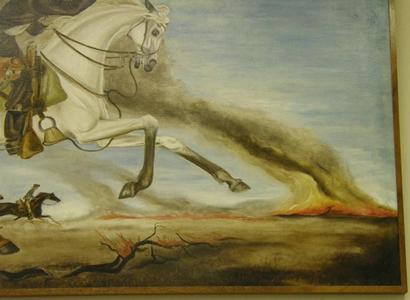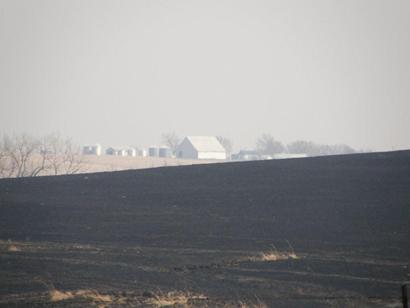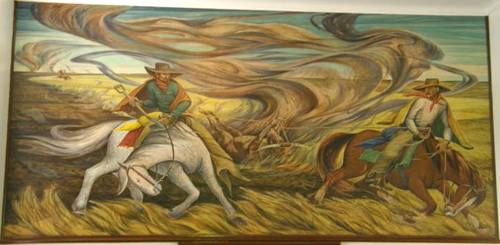| |
The
first match went out before I could get it to the kindling, which in retrospect
I should have taken as an omen.
But determined to get rid of the unsightly
pile of cedar brush, a haven for snakes and rats and other critters I did not
want too close to my country hide-out trailer, I lit a second match.
I
thought I had the perfect day to burn brush. Hardly any wind, high humidity, and
it had been a record-breaking wet spring. In fact, the ground had become so saturated
that a couple of inches of recent runoff still stood near my planned burn area.
Within
seconds after touching the match to the dry grass beneath the equally-dry cedar,
the brush pile exploded as if doused with gasoline. Flames shot at least eight
feet up, maybe higher. Unfortunately, the fire did not confine itself to the target.
To my surprise and then horror, flames began spreading in a ring around the brush
pile.
A friend and I managed to stomp out the fire line on our side, which
probably saved my SUV, but the fire kept moving in the other direction toward
a creosote-soaked utility pole, my trailer and the rest of the small ranch. Beyond
lay other people’s property.
The heat from the fire had grown so intense
I could not get close enough to even try putting put out the far side. Panting
from exertion and feeling woozy, I realized if I kept at it I might lose more
than my writing retreat. I staggered off a safe distance, grabbed a water bottle
from the cooler and decided to leave it to God.
For reasons I still don’t
understand, not too long after I’d given up the fight, the fire finally slowed
down. When the brush pile had burned sufficiently to lower the temperature, I
was able to resume my efforts and smother the rest of the flames. I think the
lowered temperature also raised the flash point for the green grass.
When
the smoke died down, I still had my vehicle and my trailer and the utility pole
still stood. Even so, I had come very close to being the cause of a lot of trouble.
And I would have had no one to blame but me.
So, take it from someone with
renewed appreciation for what happens when you mix just the right about of fuel,
heat and oxygen – be very careful. |
 |
Long
before the National Weather Service began issuing what it calls “Red Flag Warnings”
on dry, windy days with low humidity, Texans knew when prairie fires were likely
to sweep across the plains.
Still, a prairie resident or traveler often
had no more warning than seeing a long line of tan smoke on the horizon. At night,
the warning came in the form of a distant glow or perhaps the smell of burning
grass.
The experience Amanda Burks had on an 1871 cattle drive from Nueces
County to Kansas happened in Indian Territory, but it could as well have been
in Texas.
“On one occasion,” she later wrote, “a prairie fire ran us out of camp before
breakfast. We escaped by fleeing to a part of the plains which had been burned
previously, called a ‘burn’ by people of that section.”
Two
days later, she accidentally started a runaway fire.
“I tried to build
a fire in a gulley while the cook had gone for water,” she wrote. “In a flash,
after striking the match, grass all around me was in a blaze. It spread so quickly
that the men could not stop it.”
Its flames rising higher than a house,
the accidental fire raced for more than 50 miles. Fortunately, it claimed no lives.
Though Texans dread wildfires today because they threaten lives and property,
before the European settlement of the West prairie fires were merely a part of
nature’s ecological process. Fires contributed to robust grass growth and retarded
the spread of water-sucking brush like mesquite and juniper (commonly but incorrectly
called cedar.) |
 |
Charred
Kansas landscape after a controlled fire
TE photo, April 2009 |
| The same process
holding true today, blackened ranch land will eventually bloom again in spring
wildflowers. But with increased population, wildfires can no longer be considered
a simple act of natural renewal. An outbreak of sprawling wildfires in the Panhandle
in 2005 claimed 11 lives and hundreds of head of cattle, not to mention fences,
equipment and structures. |
 |
Most wildfires
start accidentally, but arson occasionally occurs. After the plains began to be
settled, igniting fires became a weapon for a time in the battle between cattle
ranchers and farmers.
In the early 1900s, as J.A. Rickard wrote in the
Cattleman Magazine in 1945, “The deeds of one settler became legendary. No one
knew his name, but he rode a white horse that could outrun any pursuer. Mounted
on his horse, he would take a long rope, saturated with kerosene and set it afire,
and drag it across the prairie in a dead run.”
Several land owners saw the culprit and a few took a shot at him, but no one ever
learned who he was, much less got their hands on him. Had they, some rancher might
have dragged him by his own fuel-soaked rope.
© Mike Cox
"Texas
Tales" June 14 , 2007 column |
|
Books by Mike Cox - Order Now |
| |